As an Amazon Associate KitchenwareSets.com earns from qualifying purchases.
7 Cozy Cabin Kitchen Ideas to Inspire Your Dream Retreat
Have you ever found yourself scrolling through images of rustic retreats, completely captivated by the warm, inviting glow of a cozy cabin kitchen? It’s the kind of space that feels like the true heart of a home, where the smell of coffee mingles with the scent of pine and every detail tells a story.
But then, reality sets in. How do you translate that dreamy, intangible feeling into a practical, functional kitchen design? It can be overwhelming to figure out how to perfectly balance rustic charm with modern convenience, especially when faced with a small space or a limited budget. You want the authenticity of natural wood and vintage finds, but you also need smart storage and efficient layouts.
The key to creating your dream retreat is to focus on seven core principles that blend natural materials, vintage character, and smart design. Drawing from countless hours of analyzing successful cabin designs and speaking with rustic interior specialists, we’ve distilled the essence of what makes a cabin kitchen truly special. These actionable ideas will guide you, whether you’re planning a full renovation or just looking for simple ways to bring that cozy cabin feeling home.
Dreaming of a Cozy Cabin Kitchen But Don’t Know Where to Start?
A cozy cabin kitchen is the heart of a rustic retreat, blending natural materials like wood and stone with vintage elements and smart design. The key is to create a warm, functional space that feels connected to nature and invites gathering. It’s more than just a place to cook; it’s the central hub for making memories.
For many, the vision is clear: a warm, welcoming space that acts as an escape from the hustle and bustle of daily life. The challenge, however, lies in the execution. How do you achieve that perfect mix of rustic authenticity and modern functionality? It’s easy to feel stuck between wanting knotty pine cabinets and needing a layout that actually works for your family.
This guide is designed to bridge that gap. We promise to provide 7 clear, inspiring, and actionable ideas to turn your dream into a reality. We’ll move beyond just pretty pictures and give you the foundational concepts—from materials and color palettes to lighting and storage—that will empower you to create a kitchen that is both beautiful and perfectly suited to your retreat.
7 Cozy Cabin Kitchen Ideas to Inspire Your Dream Retreat
The best cozy cabin kitchen ideas include: 1. Embracing Natural Materials, 2. Incorporating Rustic Elements, 3. Optimizing with Smart Layouts, 4. Choosing an Earthy Color Palette, 5. Layering Lighting, 6. Highlighting Architecture, and 7. Adding Thoughtful Decor. This curated list is based on timeless design principles seen in award-winning log homes and cherished family cottages, ensuring a look that’s both beautiful and enduring.
These aren’t just fleeting trends; they are the seven foundational pillars of a perfect cabin kitchen. Think of them as your design toolkit. Inside each idea, you’ll find practical advice and visual inspiration to guide your project. Whether you’re undertaking a complete overhaul or just looking to infuse your current space with a touch of rustic charm, these concepts will help you create a kitchen that feels both personal and timeless.
1. Embrace Natural Materials and Wood Tones
The most effective way to create an authentic cabin feel is to start with a foundation of natural materials, primarily wood and stone. These elements instantly ground the space and connect it to the surrounding landscape, creating a sense of warmth and permanence.
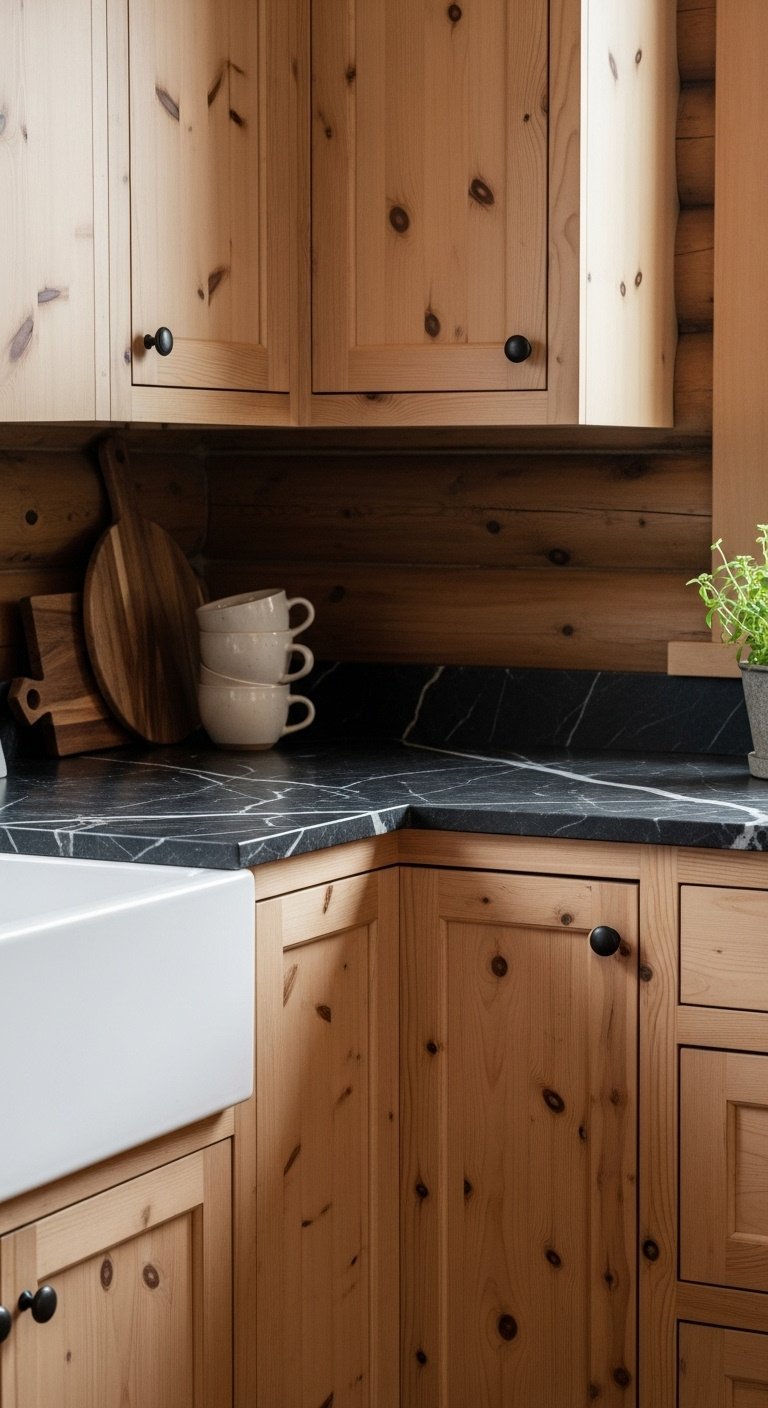
- Materials to Consider: Reclaimed wood planks, knotty pine or alder cabinets, granite or soapstone countertops, fieldstone or brick for backsplashes, exposed ceiling beams.
- Step-by-Step Directions:
- Establish a Base: Start with wood as your primary material for floors, cabinets, or wall paneling to create a warm foundation. The specific wood tone can range from light pine to deep walnut.
- Add Textural Contrast: Introduce a stone element, like a durable granite countertop or a rustic brick backsplash, to complement the wood. This contrast is key to a dynamic design.
- Incorporate Details: Weave in smaller natural textures through jute rugs, leather cabinet pulls, or ceramic pottery displayed on open shelves.
- Highlight Architecture: If you have them, make exposed wooden beams the star of the show. If not, consider adding faux beams for instant, high-impact character.
Pro-Tip: When using reclaimed wood, seal it with a matte finish. This protects the wood from kitchen splatters while preserving its natural, timeworn texture.
Pin this natural material combo for your dream cabin mood board!
2. Incorporate Rustic and Vintage Elements
To give your kitchen authentic character and charm, you should integrate rustic and vintage pieces that tell a story. These elements add a layer of history and personality that you can’t get from brand-new, off-the-shelf items.
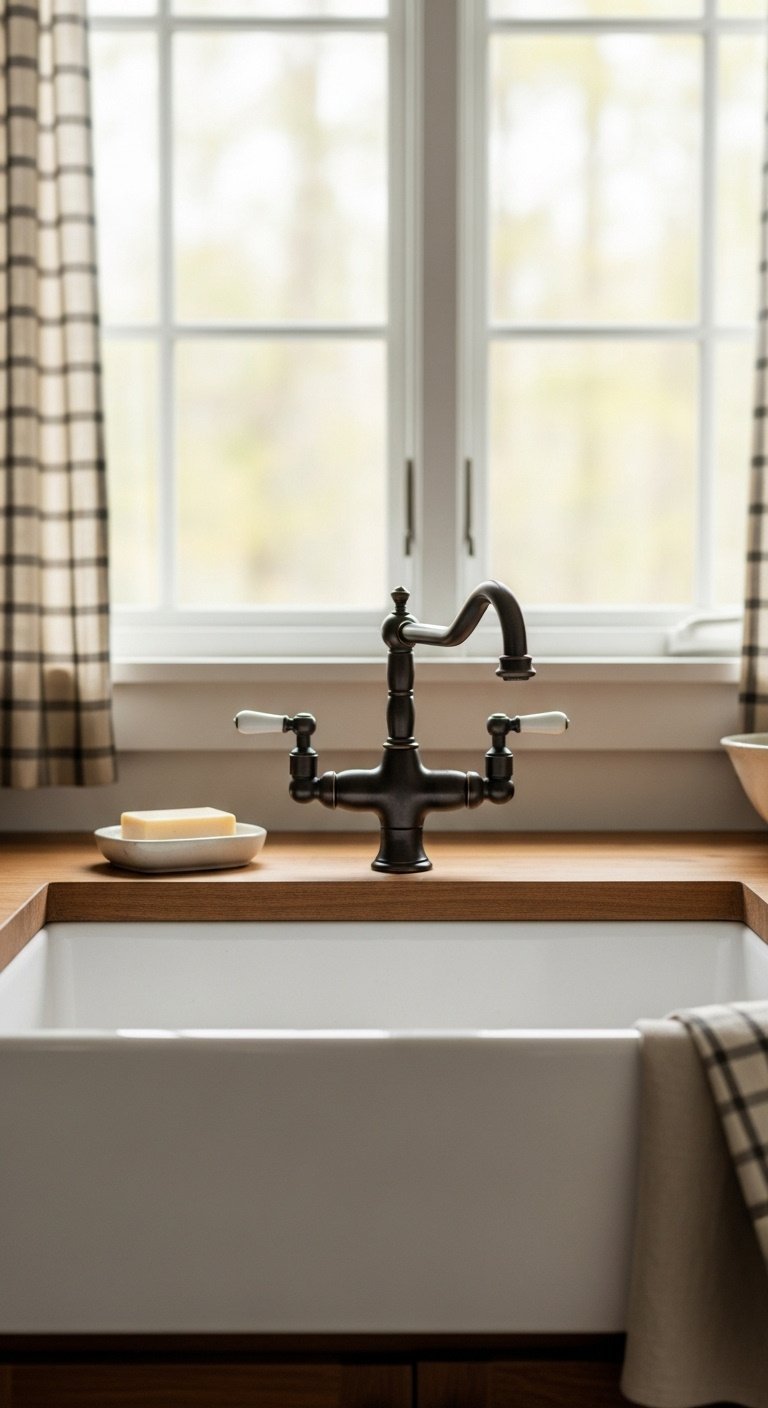
- Materials Needed: A statement piece (like a farmhouse sink), vintage-style or salvaged light fixtures, open shelving material (like reclaimed barn wood), a collection of rustic decor (pottery, cutting boards).
- Step-by-Step Directions:
- Choose an Anchor Piece: Install a classic farmhouse sink. Its deep basin and iconic apron-front design immediately set a rustic, back-country tone.
- Select Period-Inspired Fixtures: Swap modern faucets and lighting for finishes like antique brass, oil-rubbed bronze, or salvaged industrial-style pendants.
- Display Your Wares: Mount open shelves made from thick, reclaimed wood. Use them to display rustic pottery, copper pans, and heirloom wood cutting boards.
- Consider Appliances: Opt for appliances with a retro or vintage-inspired design to complete the look without sacrificing modern functionality.
Lesson Learned: Don’t be afraid to mix metals. A brass faucet can look stunning paired with cast iron skillets and dark bronze cabinet hardware, adding a collected-over-time feel that is essential for rustic charm.
Love the vintage vibe? Save this farmhouse sink idea!
3. Optimize Space with Smart Layouts and Storage
In a cabin kitchen, especially a small one, the best approach is to maximize functionality by using vertical space and flexible furniture. An efficient layout and clever storage solutions are crucial for keeping the cozy space from feeling cluttered.
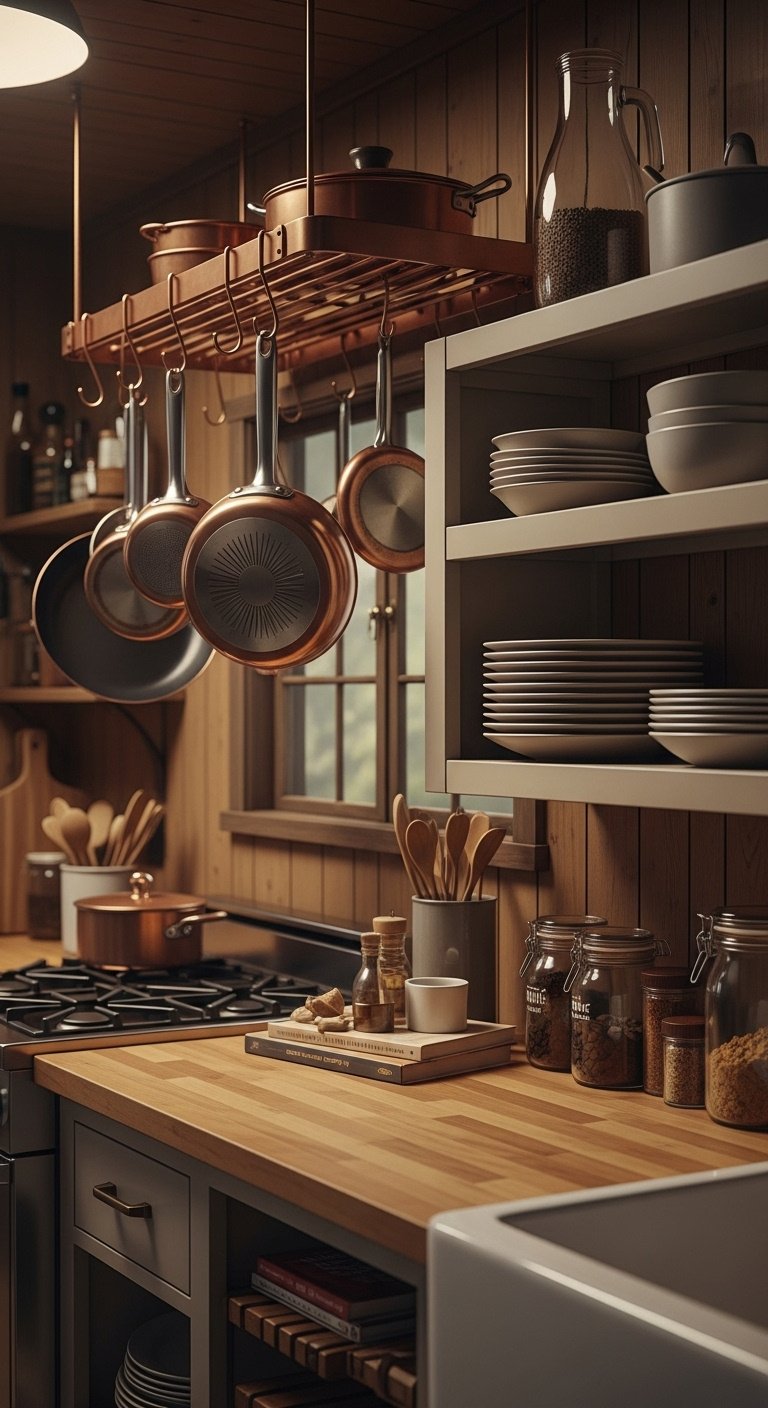
- Materials Needed: Wall-mounted open shelving, overhead pot rail, pull-out pantry organizers, a small-scale kitchen island or cart.
- Step-by-Step Directions:
- Go Vertical: Install tall cabinets or floor-to-ceiling open shelving to draw the eye upward and maximize wall space. Hang an overhead pot rail to free up precious cabinet real estate.
- Choose an Efficient Layout: For small cabins, an L-shaped or galley layout is ideal. These designs keep the work triangle (the path between stove, sink, and fridge) compact and efficient.
- Integrate Smart Storage: Use built-in solutions like pull-out spice racks, corner carousels, and even toe-kick drawers to utilize every available inch.
- Opt for Flexible Furniture: A movable kitchen island or a rolling cart provides extra prep space that can be pushed aside when not needed. A drop-leaf table is perfect for dining and can be folded down to create more floor space.
Pro-Tip: Banquette seating with built-in storage underneath the bench is a game-changer in small cabin kitchens. It provides cozy seating for a breakfast nook and a massive hidden storage area for bulky items.
Steal this space-saving idea for your small kitchen board!
4. Choose an Earthy Color Palette
The ideal color palette for a cabin kitchen involves drawing inspiration from the natural landscape with earthy tones like greens, blues, and warm browns. These colors create a calming and organic atmosphere that complements the natural wood elements.
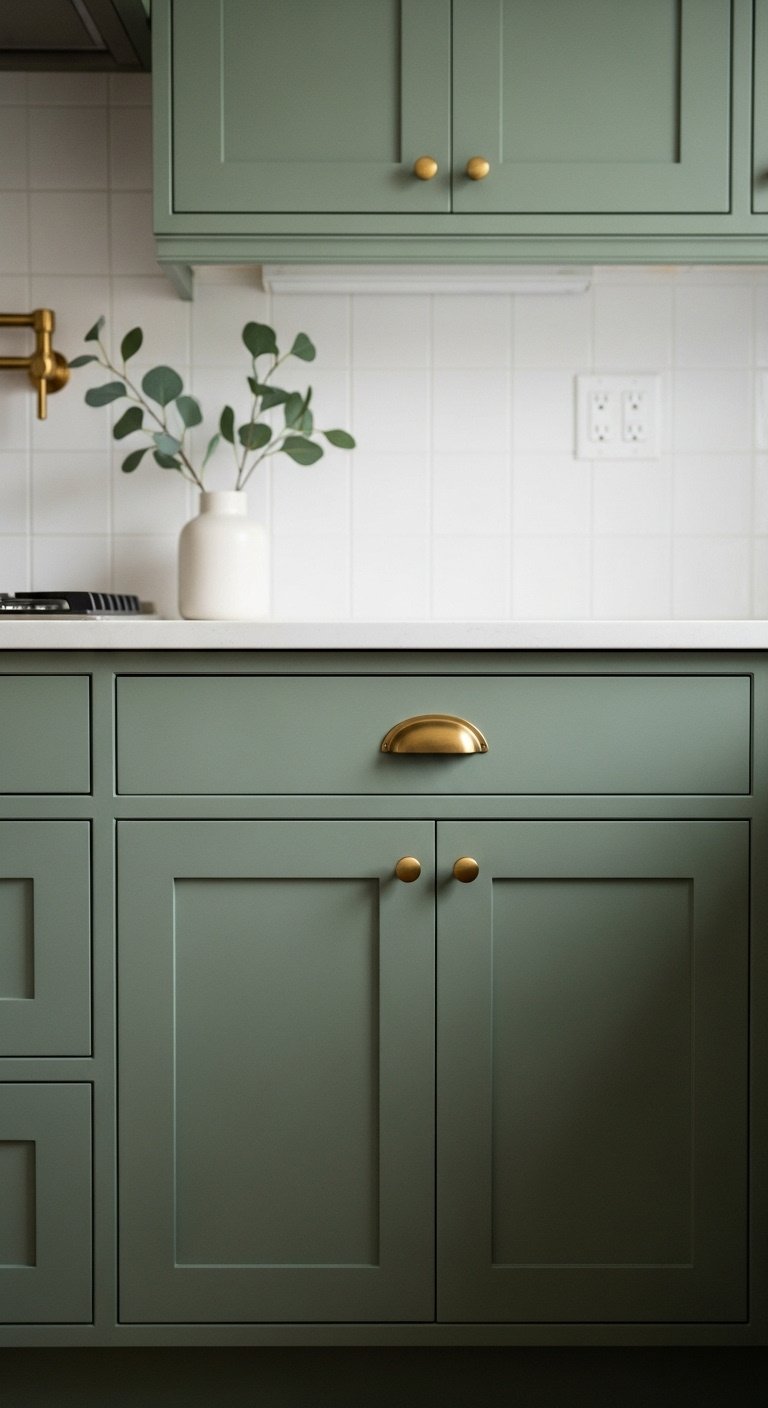
- Materials Needed: Paint swatches in earthy tones (e.g., Benjamin Moore’s “Salamander” or Farrow & Ball’s “Pigeon”), high-quality cabinet paint, painter’s tape, brushes.
- Step-by-Step Directions:
- Draw from Nature: Select a primary color inspired by the forest, mountains, or lake outside your window. Deep forest green, moody slate blue, or a soft, stony gray are all excellent choices.
- Add a Pop of Color: Consider painting your kitchen cabinets or just the island in your chosen color. This makes a statement without overwhelming the space.
- Balance with Neutrals: Keep walls, ceilings, and backsplashes in lighter, neutral tones like cream, beige, or warm white. This ensures the space feels bright and airy, not dark and heavy.
- Maintain Wood Accents: Here’s the deal: you must always balance painted surfaces with natural wood elements. Whether it’s the countertops, open shelves, or exposed beams, this contrast is essential to retaining that core cabin feel.
Lesson Learned: Before committing to a color, paint a large sample board and move it around the kitchen throughout the day. The way natural light hits can dramatically change a color’s appearance in a wood-heavy room, and what looks great online might look different in your space.
What’s your favorite cabin color? Pin this sage green inspiration!
5. Layer Lighting for Ambiance
Creating a cozy atmosphere requires a thoughtful lighting plan that layers ambient, task, and accent lighting on dimmer switches. This approach allows you to control the mood, transitioning from bright and functional for cooking to soft and intimate for relaxing.
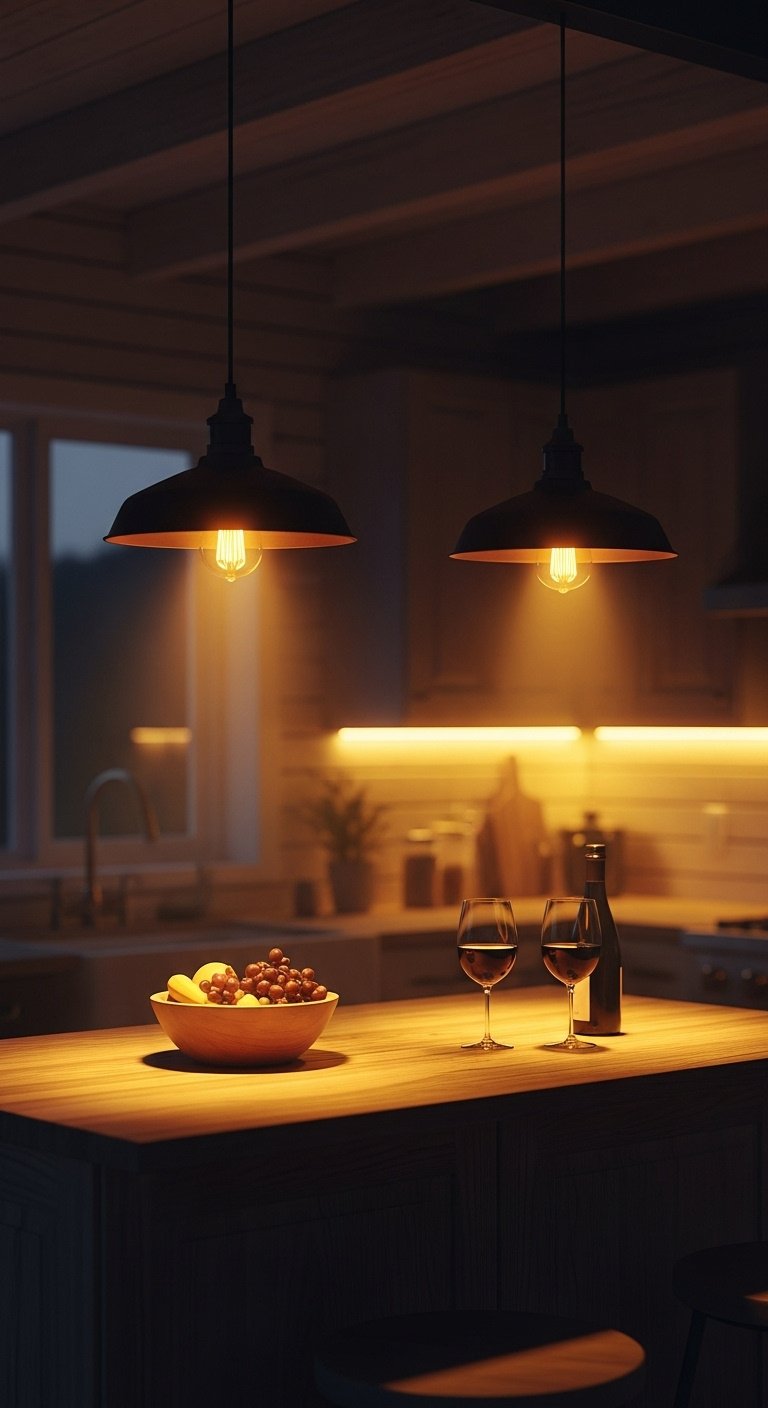
- Materials Needed: Dimmable pendant light(s), wall sconces, LED under-cabinet lighting strips, warm-toned (2700K) light bulbs.
- Step-by-Step Directions:
- Ambient Layer: Start with your main, general light source, such as recessed lighting or a central fixture. This should be on a dimmer switch to control the overall brightness of the room.
- Task Layer: Install focused lighting directly over your work areas. Hang pendant lights over the island or sink and place LED strips under the upper cabinets to brightly illuminate your countertops for food prep.
- Accent Layer: Add wall sconces to highlight architectural features like a stone wall or to create soft pools of light in corners. This layer is all about enhancing the cozy, intimate feel.
- Maximize Daylight: During the day, natural light is your best friend. Keep window treatments minimal (or omit them entirely if privacy allows) to let in as much sunlight as possible.
Pro-Tip: Always install dimmer switches on all main light sources. This is the single most effective and affordable way to completely transform your kitchen’s atmosphere from bright and functional for cooking to soft and cozy for evening conversations.
Light up your life! Save this cozy lighting scheme.
6. Integrate Architectural Details
To create a truly authentic and grounded cabin kitchen, you should highlight existing architectural features or add new ones like beams and stone accents. These structural elements provide a powerful sense of rustic character that can’t be achieved with decor alone.
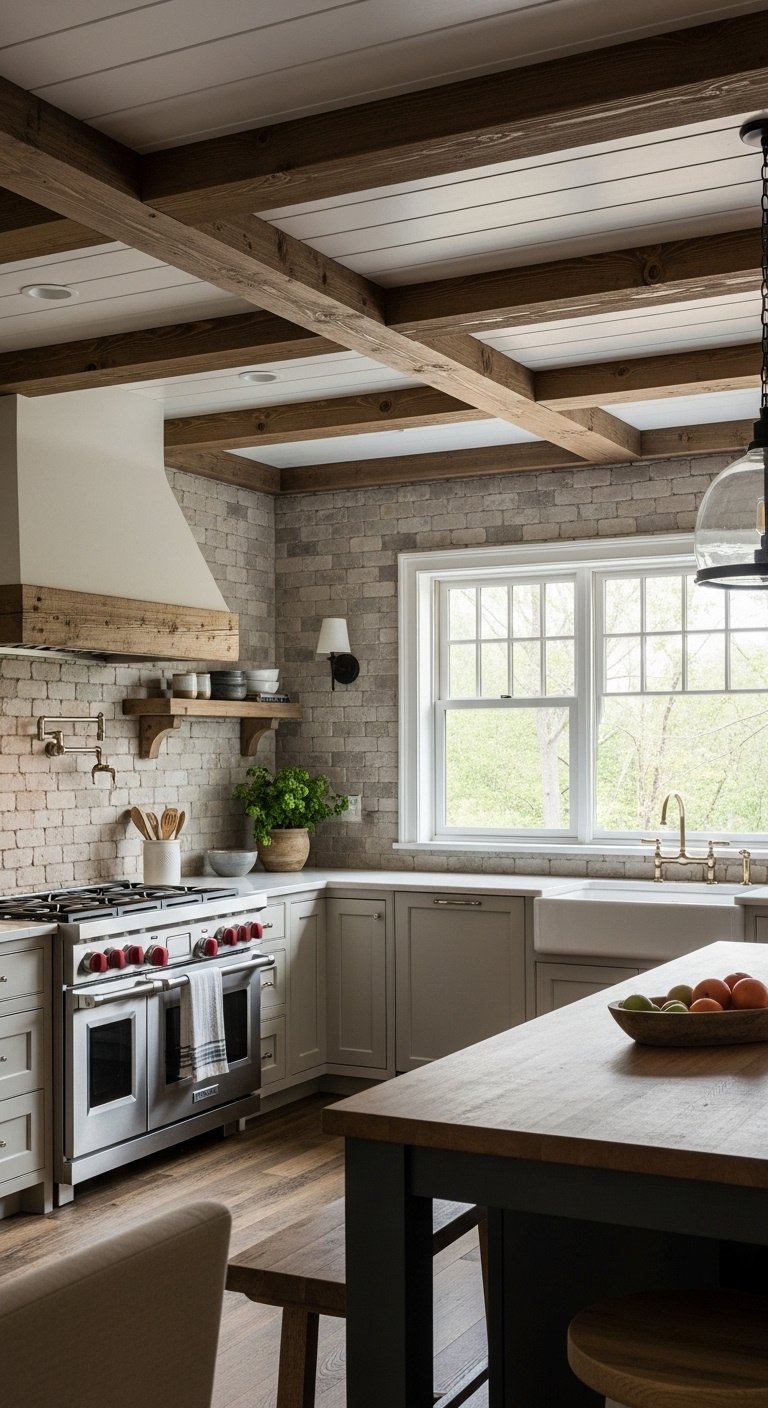
- Materials Needed: Faux wood beams (if needed), thin brick or stone veneer panels, panel adhesive, wood paneling for ceilings.
- Step-by-Step Directions:
- Look Up: Highlight existing ceiling beams by cleaning them or staining them a contrasting color. If your kitchen lacks them, install lightweight faux beams—it’s a high-impact, relatively low-cost addition.
- Create a Focal Wall: Install a stone or brick veneer on one wall to serve as a textured, rustic focal point. The wall behind the stove is often the perfect candidate for this treatment.
- Add a Textured Backsplash: Instead of standard tile, consider using the same stone or brick veneer for your backsplash. This creates a seamless, rugged look that flows from the counter to the wall.
- Frame the View: Treat large windows as an architectural feature in their own right. Keep them uncovered or use minimal treatments to connect the indoor space with the natural surroundings.
Lesson Learned: When adding a stone veneer wall, be sure to incorporate accent lighting (like a wall sconce) to “graze” the surface. This will highlight the beautiful three-dimensional texture and shadows, making it look much more dramatic and authentic.
Add instant character! Pin these exposed beam ideas.
7. Add Thoughtful Decor and Textiles
The final layer of coziness comes from thoughtfully chosen decor and textiles that add softness, personality, and warmth. These are the finishing touches that tie the whole look together and make the kitchen feel truly lived-in and inviting.
- Materials Needed: A warm-toned woven runner or rug, checkered or linen cafe curtains, woven baskets for storage/display, potted herbs (like rosemary or basil), cushions for seating.
- Step-by-Step Directions:
- Soften the Floors: Lay down a durable, warm-toned woven rug or runner. This adds softness underfoot, introduces color and pattern, and helps absorb sound in a room with many hard surfaces.
- Dress the Windows: Hang simple checkered or linen cafe curtains. They add a touch of charming, cottage-style privacy without blocking precious natural light.
- Bring Nature Indoors: Place potted herbs on the windowsill for fresh ingredients and a touch of life. A vase of wildflowers or greenery on the counter instantly adds a fresh, organic element.
- Display Collections: Group useful, beautiful items to personalize the space. Woven baskets for fruit, a collection of vintage ironstone pitchers, or nature-themed artwork all add character.
Pro-Tip: Don’t underestimate the power of textiles. A simple switch from bare wooden stools to stools with plush cushions can instantly make a kitchen seating area feel dramatically more comfortable and inviting for guests to linger.
Get cozy! Save this idea for the perfect finishing touches.
Key Takeaways: Your Quick Guide to a Cozy Cabin Kitchen
Here’s a quick recap of the most important principles for creating your dream cozy cabin kitchen.
* Prioritize Natural Materials: Wood and stone are the foundation. Use them generously on floors, cabinets, countertops, and walls to create an authentic, warm base.
* Embrace Imperfection: Choose rustic and vintage elements over shiny and new ones. Items with a bit of history and patina add character and a sense of soul to the space.
* Layer Your Lighting: Combine ambient, task, and accent lighting. Most importantly, use dimmer switches to create a warm, functional, and moody atmosphere that can change with your needs.
* Think Vertically for Storage: In small spaces, use tall cabinets, open shelving, and overhead pot rails to keep countertops clear and maximize every square inch.
* Finish with Soft Textures: Don’t forget the final layer! Textiles like rugs, cushions, and curtains are absolutely essential for adding the softness and comfort that define “cozy.”
People Also Ask About Cozy Cabin Kitchens
What is a cottagecore kitchen?
A cottagecore kitchen embraces a romanticized, rustic aesthetic inspired by a simple country cottage. It features eclectic, cozy, and antique elements like open shelving with vintage dishes, farmhouse sinks, checkered textiles, and an abundance of natural materials. The focus is on creating a warm, lived-in space that feels harmonious with nature and celebrates handmade charm.
What kitchen design never goes out of style?
Kitchen designs that prioritize natural materials, simple forms, and high functionality tend to be the most timeless. A classic cabin kitchen, with its heavy use of wood, stone, and a neutral or earthy color palette, is a perfect example. Features like simple shaker-style cabinets and iconic farmhouse sinks have an enduring appeal because they are both beautiful and incredibly practical.
How can I make my small cabin kitchen feel larger?
To make a small cabin kitchen feel larger, you should focus on light and verticality. Maximize natural light by using minimal window coverings. Use a light color palette on the walls to help reflect that light around the room. Employ vertical storage solutions like tall cabinets or floor-to-ceiling open shelving to draw the eye upward, creating an illusion of height. Finally, use smart layouts and keep countertops as clutter-free as possible to maximize the sense of open space.
Final Thoughts
Creating a cozy cabin kitchen is less about following a rigid formula and more about crafting a feeling. It’s about building a space that welcomes you in, encourages you to slow down, and becomes the backdrop for your best memories. Your cabin kitchen should be a reflection of you and your retreat’s spirit.
By blending these ideas—choosing materials that feel good, layering light for warmth, and adding personal touches—you can create a space that’s not just beautiful, but truly the heart of your home.
Which of these ideas are you most excited to try in your own space?
